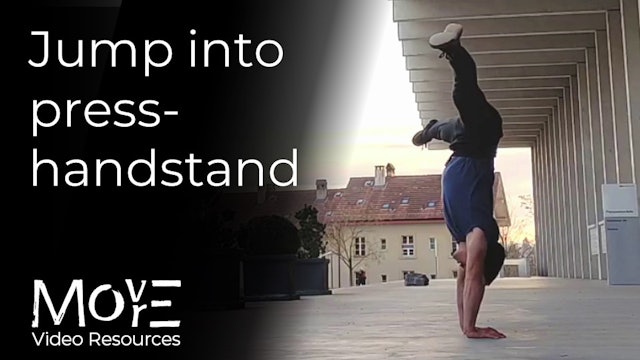Handstand balance contexts
These handstand-balance contexts provide years of practice toward developing both linear (i.e. extending the capacity for time in balance) and lateral (exposure to a range of contexts) experience in the two-arm handstand. As well as exploring different forms and leg positions which serve to heighten structural-awareness and proprioception, certain contexts, notably those performed with "head-in", expose the practitioner to loads and overhead pushing mechanics highly transferable to straight-arm strength movements such as the 'Press handstand' and can also build preliminary foundations to practice balancing on one arm.
For the practitioner coming from 'supported-balance' contexts, however, it is advised to make the LINEAR development (i.e. simply increasing balance time) of your freestanding straight-line handstand the primary project, and to keep it so until sets of consistent 30" of balance are achievable (this may very well represent some years of consistent practice); the freestanding 'tuck-HS' is also worth equal investment and can be practiced in tandem with the straight-line, as the fundamental 'tuck' form becomes more transferable when exploring new handstand shapes in which the weight of the legs shifts to the front of the body (remember the "counterbalance" of the backside is a fundamental feature of the 'tuck-HS' structure).
LEARN MORE (subscriber-only):
https://drive.google.com/file/d/1f0OAwmZjqnBudWG5_w4vKpCcoVO46rTV/view?usp=drive_link
-
Straightening out the HS line
THE WHAT:
Further to simply balancing on two hands for as long as possible (quantity), if you plan to expand your handstand vocabulary further then your journey begins with attending to any breakdown areas in what can be defined as the "true" straight-line handstand (quality).In many cases this...
-
Kick-up to straight-line handstand (reps)
THE WHAT & WHY:
A simple context for developing the consistency of your kick-up into straight-line HS. The objective is to develop EFFICIENCY: the kick-up should feel as easy as possible, use as little energy as possible, make as little noise as possible on landing and use the REBOUND to re-enter... -
Kick-up to straight-line HS hold
THE WORK OF BALANCE:
Development of the freestanding, straight-line handstand should remain the number-1 focus to those progressing from 'supported-balance' contexts. Having been said, it is important to "soften" your desire to simply balance, because it will take MUCH time and consistent, patien... -
Jump to tuck-handstand (reps)
THE WHAT & WHY:
A simple context for developing the consistency of your jump into tuck-HS form. The objective is to develop EFFICIENCY: the jump-up should feel as easy as possible, use as little energy as possible, make as little noise as possible on landing and use the REBOUND to re-enter the ne... -
Jump to Tuck-handstand hold
THE WHAT & WHY:
Some fundamental qualities of the 'Tuck-HS' to help develop understanding of the form and mechanics required to sustain it. Whilst it is recommended to place focus on learning your 'Straight-line' handstand before 'Tuck-HS', they can also be practiced/developed in tandem, with exp... -
Jump into press HS
THE WHAT:
Whilst this context does not significantly contribute to the straight-arm strength required to perform the full 'Press handstand', it allows development of the "popping" texture required for an efficient jump-up into straddle-handstand position which contributes to calibration of power-... -
Splits & straddle HS balance
THE WHAT & WHY:
The 'split' and 'straddle' are very simply & approachable options for expanding your experience of balancing handstand forms. Whilst it is advisable to already have some experience with your straight-line balancing handstand (consistent holds of 10-20 seconds) before opening more ... -
Handstand leg-proprioception sequence A
THE WHAT & WHY:
Whilst exploring different shapes and handstand forms helps to develop proprioception of the legs (i.e. where they are in space), their dynamic movement inevitably causes moderate to significant weight-shifting in inversion.The practice of continual re-/calibration of balance to...
-
Handstand straddle leg-extensions
THE WHAT & WHY:
Once you have developed your fundamental straight-line handstand to consistent hold times of at least 30-seconds and have some experience holding handstand in a basic straddle form, (i.e. legs straight & apart), adding some movement of the legs will both require you to invite and ... -
Handstand open/closed-shoulder reps
THE WHAT:
Patterning the open-to-closed & closed-to-open-shoulder handstand forms with an eye toward its application in progressive handstand strength movements, such as the 'Press HS' and 'HS pushup'. In the press-handstand, it represents the final 'opening' of the shoulders after the press whic... -
Forward-facing Tuck & Straight-line HS
WHAT & WHY:
Practicing movement of the head in handstand forms will help to develop proprioception (awareness of the position of the body in space) and refine structural awareness toward ongoing development of your 2-arm handstand; a simple place to start is shifting the head into a FORWARD-facin... -
'Head-in' straight-line & tuck HS
THE WHAT & WHY:
Fundamental 'head-in' handstand contexts for straight-line & tuck HS. As well as developing proprioception & vestibular system in inversion, the full 'head-in' position (chin 'tucked' & looking at feet/knees) allows for greater activation of UPPER-back muscles to stabilising the s... -
Tuck-handstand 'tik-toks'
THE WHAT:
The tuck-handstand 'tik-toks' allow you to develop experience of manipulating the spine in the frontal plane (i.e. sideward movement) whilst maintaining the integrity of your tuck-HS form. As such, it develops general proprioception (i.e. of where everything from the spine, down, is in ... -
Straight-line to Tuck-handstand
THE WHAT:
Once both 'straight-line' and 'tuck-HS' forms have been developed, putting them together allows for practice of dynamic balance work. This also develops your understanding of the differences between straight-line & tuck (namely the need to shift into COUNTERBALANCE for the latter), refi... -
Piked tuck-handstand forms
THE WHAT & WHY:
The 'piked' tuck-HS is a progressive tuck-HS variation in which the legs are extended fully. As such, the "load" to the front of the body (that which is normally the BENT legs in the fundamental 'tuck-HS) is greater and, consequently, more strength application to maintain the open...

















